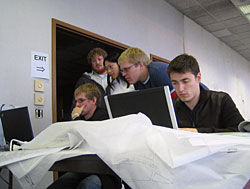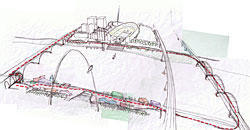The Gateway Arch is an icon of modern architecture and the most-recognized symbol of the City of St. Louis. Yet in many ways the Arch is cut-off from the city proper, sandwiched between the Mississippi Riverfront and a network of converging roadways and interstates.

Last month a group of 41 students in art, architecture, landscape design and transportation engineering — representing five Missouri and Illinois universities — gathered at the Mansion House complex, 300 N. 4th St., to address this challenge as part of the St. Louis Downtown/Riverfront Student Design Charrette.
Organized by the St. Louis Chapter of the American Institute of Architects and the Transportation Engineering Association of Metropolitan St. Louis, the charrette was held Nov. 6 to 9 and sought to explore new possibilities for improving the function, connections and vitality of the central riverfront — specifically the Gateway Arch and surrounding grounds; Memorial Drive; and sections of Interstate 70.
Students, working in teams of six, brainstormed dozens of ideas and strategies. Specific design objectives included maximizing the impact and pedestrian connections between downtown, the Arch and the Mississippi Riverfront; developing ways to extend the Arch grounds west across Memorial Drive; and incorporating new attractions and amenities to make the area a year-round activity center for both residents and tourists.
“This charrette was an invaluable experience for the students,” noted Patricia Heyda, LEED, AP, visiting assistant professor of architecture, who organized the Washington University participants. “It allowed them to cross interdisciplinary lines and work on a real problem in St. Louis while also demonstrating the value of collaboration.

“In a very limited time, issues were raised, problems presented and provocative design ideas generated,” Heyda added. “This couldn’t have happened without the focused input of such mixed disciplines as traffic engineering, architecture, urban design, landscape architecture and art — or without the support of local professionals and organizations, who donated resources, time and knowledge towards the academic exercise.”
One proposal — co-authored by Andrew Faulkner, a graduate student in architecture and urban design — would strengthen connections between the Arch grounds and the nearby Laclede’s Landing neighborhood by relocating a large concrete parking garage that currently separates them.
Another design — co-authored by Glen Timmons, a graduate student in the Sam Fox School of Design & Visual Arts — would facilitate pedestrian traffic by spanning Interstate 70 with a large earth bridge stretching from the Arch grounds to another St. Louis monument: the historic Old Courthouse, 11 N. 4th St. Timmons’ team also suggests creating an open-air stadium on the Mississippi’s eastern bank as well as a new ferry system and an elevated river walk.
All design boards are on view at the Landmarks Association of St. Louis, 911 Locust St., Dec. 3 through Jan. 15, 2009. Next spring they will return to campus for a display in Steinberg Gallery, which will be held in conjunction with the Mildred Lane Kemper Art Museum’s Eero Saarinen retrospective opening Jan. 30.